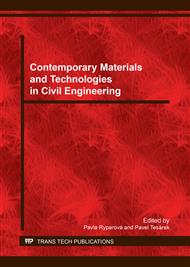p.1
p.10
p.15
p.23
p.29
p.37
p.43
p.49
p.55
Influence of Micro-Milled Secondary Materials Used as Binders in Low Level Stabilized Cold Recycled Asphalt Mixtures
Abstract:
This paper presents an experimental verification of the alternative options for using by-products or mineral waste materials applied to cold recycled mixtures with low level of stabilisation intended for low-volume road structures. To achieve the necessary refinement and a certain level of reactivity potential, the by-products were activated mechanically, i.e. pulverized in a high-speed disintegrator with respect to the lowest possible energy demands of the process and to the level of wear-and-tear of the working components in the milling machine. Such refined material, with average particle size of 10-15 μm, is applies as an active filler component allowing to partly substitute hydraulic binder in cold recycled mixtures. The application of such materials in structural pavement layers should increase the environmental benefits and result in added economic value. The experimental measurements taken focused on cold recycled mixtures with low level of stabilisation, modified by a combination of binders, or namely cement, mechanically activated concrete from reclaimed concrete pavement slabs originating from the Czech backbone D1 highway modernisation, mechanical-chemically activated fluid ashes from the Pilsen heat plant and foamed bitumen. Both basic volumetric properties and strength and deformation parameters were set for the purposes of evaluation of the characteristic measured in the experimental mixes.
Info:
Periodical:
Pages:
29-36
Citation:
Online since:
March 2017
Authors:
Price:
Сopyright:
© 2017 Trans Tech Publications Ltd. All Rights Reserved
Share:
Citation:


